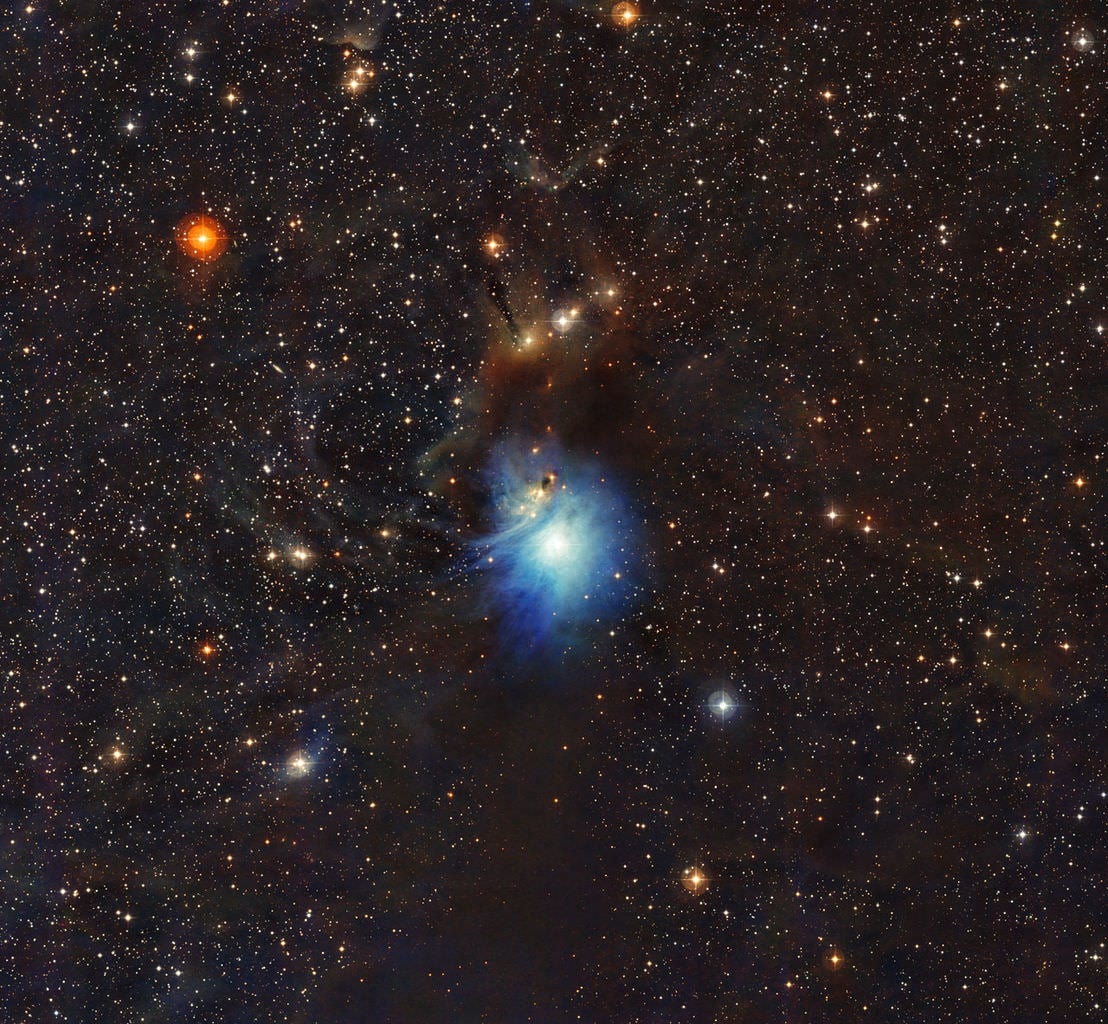Imagine yourself in a boat on a great ocean, the water stretching to the distant horizon, with the faintest hints of land just beyond that. It's morning, just before dawn, and a dense fog has settled along the coast. As the chill grips you on your early watch, you catch out of the corner of your eye a lighthouse, feebly flickering through the fog.
And - yes - there! Another lighthouse, closer, its light a little stronger. As you scan the horizon more lighthouses signal the dangers of the distant coast.
[caption id="attachment_135530" align="alignnone" width="1108"]
A newly formed star lights up the surrounding cosmic clouds in this image from ESO's La Silla Observatory in Chile. Dust particles in the vast clouds that surround the star HD 97300 diffuse its light, like a car headlight in enveloping fog, and create the reflection nebula IC 2631. Although HD 97300 is in the spotlight for now, the very dust that makes it so hard to miss heralds the birth of additional, potentially scene-stealing, future stars. Imsge: ESO[/caption]
You know this coastline, returning to the same port year after year. You know the lighthouses are all the same brightness, made by the same manufacture and kept in good working order throughout the years.
And so to pass the time you play a little game. Consulting your charts, you know the distance to each lighthouse, and how far their light has traveled to reach your salt-stung eyes. But their light, bright and glaring on a clear evening, is dimmed and shadowed by the persistent fog. You know how bright they
ought
to be, and you can compare that brightness to what you see, peering through the layers and layers of fog, to estimate just how much fog is hugging the coastline.
It's not like you've got anything better to do.
Cosmic Fog
This is exactly the procedure that
astronomers recently used to measure the total amount of starlight
in the universe - minus, of course, the fog and lighthouses and salty sailors.
Our cosmic lighthouses are the active galaxies, the most powerful engines in the universe, where matter flowing into gigantic black holes compresses and heats up,
igniting in a blaze of radiation
before getting swallowed by the event horizon. In their death throes these swirling, chaotic clumps of gas emit more energy than millions of galaxies, and are capable of pumping their light throughout the universe.
When they ignite in the young cosmos, they appear to us as lighthouses, gleaming but distant.
[embed]
In between those lighthouses and our telescopes is all the
stuff
in the universe. Most of the universe is empty void, but filling those voids is the accumulated light from all the generations of stars that have lived and died since those distant epochs, illuminating the cosmos in a dim and thin fog of photons.
The radiation coming from the distant active galaxies is extremely high energy - no surprise, given the mighty nature of their origin. And as that high-energy light blasts through the universe, it encounters that thin fog. Chance interaction by chance interaction, random collision by random collision, the high-energy radiation loses energy and scatters.
Through a Glass, Darkly
By examining the light from over 700 active galaxies, the team of astronomers was able to estimate all the starlight produced throughout the entire universe and throughout cosmic time, from just after the time of the first stars a mere 500 million years after the big bang until close to the present day. The rough count? 4x10^84 photons, which is...a lot.
This estimate agrees with other calculations of this so-called extra-galactic background light, but buried in this latest observation and others is a troubling finding: our universe is dying.
By comparing the light from different active galaxies placed at different distances from us, the astronomers could not only calculate the total amount of starlight ever produced, but also trace the ebbs and flows of that starlight through billions of years of cosmic history.
[embed]
And the terrible news is that the lights are going out, one by one. As best as we can tell, across a variety of observations and estimations, is that our universe peaked in star formation over 9 billion years ago, when the cosmos was just a quarter of its present age.
The precise reason still eludes us. Most certainly our expanding universe has something to do with it - galaxies are getting further away from each other on average, resulting in fewer mergers and fewer supplies of fresh material flowing into galaxies, where they can churn that gas into new stars. But why was the peak at that moment, so long ago? Why did star formation decline so quickly? Or, perhaps, why have stars persisted for so long, despite the collapse of their once-great empire?
Difficult questions with no easy answers. For now, at least, we're still in the fog.
Read more: "
A Gamma-ray determination of the Universe's star-formation history
"
 Universe Today
Universe Today

